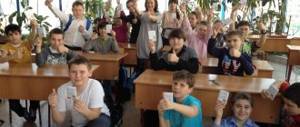In this chapter we will look at existing types of creative projects , and also analyze the types of creative work of students in secondary schools and preschool institutions. In order to invite a child to engage in project activities, the teacher must clearly define the type and type of project being created with the student or group of students.
Often creative projects are divided into types of creative projects or types of creative work, such definitions and their differences need to be understood.
The description of definitions below also concerns such definitions as types of project work and types of project work of schoolchildren as part of their research and design activities.
Types of creative projects
A group project is a joint educational, cognitive, research, creative or gaming activity of student partners that has a common problem, goal, agreed upon methods and ways of solving the problem, aimed at achieving a joint result.
An individual project is a creative project carried out by one student under the guidance of a teacher.
An information project or an information and creative project, the structure of which places an emphasis on presentation. Also, the concept of a creative and information project is used.
A research project is a project whose main goal is to develop and test a hypothesis.
Short-term project – a project lasting from 1 to 6 lessons.
A practice-oriented project is a project whose main goal is to produce a tool suitable for solving any applied problem.
A role-playing project (game) is a project in which initially only the roles of the participants and the rules of the relationship between them are defined, while the structure, form of the product and the results remain open until the very end.
Medium-term project – a project lasting from one week to one month.
A creative project is a project whose center is a creative product - the result of self-realization of the project group participants. Creative projects can have the following directions:
- musical and creative project;
- artistic and creative project.
Telecommunications project (educational) – a group project organized on the basis of computer telecommunications.
An educational project is a project carried out by students under the guidance of a teacher and having not only a pragmatic, but also a pedagogical goal.
Learning Project Objectives in Primary School
The use of this method in lessons and in extracurricular activities allows the teacher to teach children:
- independently formulate problems and solve them;
- search for information, analyze it, highlight the main thing;
- apply in practice the knowledge acquired in the lessons;
- be creative in solving problems;
- manage your time effectively;
- collaborate with other students and adults;
- master unfamiliar technologies during the production of the final product;
- conduct research (put forward a hypothesis, study theory, conduct experiments, organize surveys, collect evidence, draw conclusions);
- analyze the progress of work, its results and success;
- demonstrate the resulting product, briefly but fully talk about it;
- speak in front of the public and argue your opinion.
Types of creative projects and design work
In this chapter we will look at the existing
types of creative work by students of schools, lyceums, and gymnasiums. In accordance with the method dominant in the project, the following types of creative projects for schoolchildren can be distinguished:
Research projects
Such projects require a well-thought-out structure, defined goals, relevance of the subject of research for all participants, social significance, appropriate methods, including experimental and experimental work, methods for processing the results. These projects are completely subordinated to the logic of research and have a structure that approximates or completely coincides with genuine scientific research.
This type of project involves arguing the relevance of the topic taken for research, formulating the research problem, its subject and object, designating research tasks in the sequence of accepted logic, defining research methods, putting forward hypotheses for solving the identified problem, developing ways to solve it, including experimental, experimental, discussion of the results obtained, conclusions, presentation of the research results, identification of new problems for further development of the research.
Role-playing, game projects
In such projects, the structure is also just outlined and remains open until the work is completed. Participants take on certain roles determined by the nature and content of the project. These can be literary characters or fictional heroes, imitating social or business relationships, complicated by fictitious participants in the situation.
The results of these projects are either outlined at the beginning of their implementation or appear at the very end. The degree of creativity here is very high, but the dominant type of activity is still role-playing.
Creative projects
It should be noted that a project always requires a creative approach, and in this sense, any project can be called creative.
But when determining the type of project, the dominant aspect stands out. Creative projects require appropriate presentation of the results. Such projects, as a rule, do not have a detailed structure of the joint activities of the participants; at first it is only outlined and then develops, subordinating to the genre of the final result.
Such a result could be: a joint newspaper, an essay, a video film, a performance, a game, a holiday, an expedition, etc. However, the presentation of the results of the project requires a clearly thought-out structure in the form of a script for a video film or performance, a holiday program, an essay plan, an article, a report, and so on, the design and headings of a newspaper, an almanac, an album, and so on.
Introductory and orientation (information) projects
This type of project is initially aimed at collecting information about an object or phenomenon; It is intended to familiarize project participants with this information, analyze it and summarize facts intended for a wide audience. Such projects, just like research ones, require a well-thought-out structure and the possibility of systematic correction along the way.
The structure of such a project can be indicated as follows: the purpose of the project, its relevance, sources of information, brainstorming, information processing (analysis, generalization, comparison with known facts, reasoned conclusions), result (article, abstract, report, video and other). Presentation. Such projects are often integrated with research projects and become their organic part, a module.
Practical (applied) projects
These projects are distinguished by clearly defined results from the activities of their participants from the very beginning. Moreover, this result is necessarily focused on the social interests of the participants themselves. Such a project requires a carefully thought-out structure, even a scenario for all the activities of its participants, defining the functions of each of them, clear conclusions, that is, the presentation of the results of project activities and the participation of everyone in the design of the final product.
Here, good organization of coordination work is especially important in terms of step-by-step discussions, adjustments to joint and individual efforts, in organizing the presentation of the results obtained and possible ways to implement them in practice, as well as systematic external evaluation of the project.
Project activities in elementary school: how to captivate modern children?
Children are explorers by nature. Should teachers not know? A project is a proven way to give a student the opportunity to independently study and collect the necessary information, combine it, draw conclusions, and present it. Project activities develop:
- creativity;
- independence;
- ability to work with information;
- research skills.
And, yes, this is only a small part of why project activities need to be introduced in the lower grades.
What kind of projects are there?
Let's talk about types of projects. For a project to be successful, the teacher must know the specifics of its implementation.
Research.
Experiments! Children experiment, actively study some area, and then these results are compiled into a wall newspaper, presentation, booklets - whatever their imagination allows. By the way, this is a great way to prepare schoolchildren for university - after all, there they will have to do the same activities - only in the form of course projects!
Game.
Project activities in the form of games and performances. Each student plays a certain role (for example, a fairy-tale character) and offers his own solution to the problem. Please note: game projects require a lot of prep work.
Creative.
Freedom of imagination! How to collect information, work with it, and present it is up to the student to decide. This could be: creating a video, poster, magazine, etc.
Practice-oriented.
Aimed at the social interests of students. Such a project can be used in the life of a class or an entire school. You can develop small manuals: “Rules of conduct in the classroom”, “School: basic safety rules”, etc. Engaging in this activity will help children structure information in the future.
Choosing a topic: 3 main rules.
1. Interest.
The topic should arouse interest among primary school children. Nobody wants to engage in an activity they don't like. And the result will be much more effective if the child works on a project whose topic the child likes. Play the game "Ask a Scientist" with your students. Let the children imagine that they have met a professor who can answer any of their questions. Why don't chickens fly? How does a helicopter work? These questions may be the topic of a future project for elementary school students.
2. Availability.
Remember that you are working with children. With small children. The topic should be appropriate for the age of the students, do not complicate it. And the acquired knowledge should be useful to the project participants.
3. Speed.
Consider the characteristics of young children: they find it difficult to concentrate for long periods of time. Therefore, work on the project must be completed relatively quickly.
Step by step: 5 stages of creating a project.
When working on projects, remember the rules of the five Ps: Problem - Planning - Information Search - Product - Presentation.
Let's consider 5 main stages when working on a project:
1. Define the problem.
It is important to identify a research problem that will be of interest to a child in elementary school.
2. Define goals and objectives.
Why are we doing research? What do we want to find out? The teacher must give the students the right direction.
3. We plan the implementation of the project.
Help the students decide on the form for carrying out the project activity, what will it be: a booklet, a newspaper, a video? Determine exactly how you need to collect information and where. If the project is a group project, help the children distribute responsibilities.
4. Let's implement.
When the first steps in working on the project have been taken: information has been collected, all ideas have been put forward, you can begin to design it. Elementary school students are not yet very good at generalizing facts - this is where the teacher comes to the rescue. Discuss how the project will be presented (don’t get carried away, remember, independence is important here!).
5. Let's summarize.
Time to present your projects! Project activities can be represented by a stand with wall newspapers, presentations, even an exhibition. Don’t forget to discuss with your children what you liked and what you would do differently.
The role of the teacher.
In primary school, the role of the teacher is especially important in the first and last stages. It is important to involve children in the process - the success of project activities depends on this. But don't forget that you are just a helper. You do not pass on knowledge, but monitor the activities of schoolchildren. What role can a teacher play?
- “Enthusiast”: actively involves children in activities.
- “Specialist”: students can contact with any question.
- “Manager”: helps to create a project plan.
- “Coordinator”: organizes the guys.
- “Expert”: evaluates the results of the prepared project.
The role of the student.
Active participants! In project activities, schoolchildren are freed from the role of passive extras. The role of the student depends on the stage of work. But at all stages the project participants:
- They make decisions.
An important process, because this is how the child learns to take responsibility. And for younger children, this is a kind of privilege - they trust him in their choice. - Learn to work in a team.
Here the child learns to communicate not only with peers, but also with adults. You may need to talk to other teachers, a librarian, etc. - Evaluate.
To teach children adequate self-esteem, give them the opportunity to think about what participation in project activities gave them, what went well, and what could be improved.
Features of organizing a project in elementary school.
- The topic should be close to the students. Even though we talked about it, a reminder is not superfluous. Sometimes you can get so carried away and forget that the project is being done for the children, not the teachers.

- Duration of project work. A couple of weeks of in-class/extracurricular activities will be enough. Do not forget that we are dealing with elementary school students - they can quickly get bored with such activities for a long time.
- Go on excursions, organize observation walks, social events. All this will help in the process of working on the topic and will increase the interest of children.
- Consider the individual characteristics of each child. Some people like to work in a group, others are more comfortable alone, so that no one disturbs them - and that’s normal!
- Motivate! Create different nominations: Project-surprise/discovery/creativity/surprise - children will try to get such a merit.
The introduction of project activities makes it possible for young children to independently learn to collect and select information, make decisions, and negotiate with other project participants. Don’t forget that over time, projects can become more complex and computer technology can be introduced. But we think that in the 21st century children definitely keep up with technology!
Want more useful collections, tips, ideas? Subscribe to our instagram.com/diso.ru
and VK group:
vk.com/disoru
. Useful content every day!
Types of projects based on “Subject content area”
Based on the “Subject content area” attribute, the following two types can be distinguished:
Interdisciplinary projects with schoolchildren
Such projects are usually carried out outside of school hours.
These are either small projects affecting 2–3 subjects, or quite voluminous, long-lasting, school-wide projects planning to solve one or another rather complex problem that is significant for all participants in the project. Such projects require very qualified coordination on the part of specialists, coordinated work of many creative groups with clearly defined research tasks, well-developed forms of intermediate and final presentations.
By the nature of contacts, projects can be regional and international projects .
, individual and group projects can be distinguished .
According to the duration of implementation, projects can be: short-term (can be developed in several lessons), medium duration (from a week to a month), long-term (from a month to several months).
Of course, in real life, most often we have to deal with mixed types of projects , in which there are signs of research and creative, as well as other projects. However, the research project method occupies a central place and at the same time causes the greatest difficulties.
It is based on the development of the ability to master the world around us on the basis of scientific methodology, which is one of the most important tasks of general education. The project method requires a change in the teacher's position. From a carrier of ready-made knowledge, he turns into an organizer of the cognitive activity of his students.
The psychological climate in the classroom is also changing, as the teacher has to reorient his teaching and educational work and the work of students to various types of independent activities of students, to the priority of activities of a research, search, and creative nature.
Types of projects by dominant activity
This classification is considered the main one, as it reflects the substantive specificity of the work. According to it, the following types of projects in elementary schools according to the Federal State Educational Standard are distinguished:
- Practice-oriented. The work is carried out in accordance with a clear order for the final product. It is assumed that it will be used to solve some problems. For example, children should make teaching aids for the whole class or bird feeders.
- Research. By completing it, children turn into real scientists. They put forward hypotheses, conduct experiments and sociological surveys, build working models, studying the chosen problem.
- Informational. Schoolchildren collect reliable data about some object or event, format it in the form of an article, essay, book and present it to a wide audience.
- Creative. The results of the study are presented in an unconventional way. It can be a craft, a drawing, a video, a theatrical skit, a game, poems and fairy tales of one’s own composition.
- Role-playing. For younger schoolchildren, this is the most difficult type of project. Children take on the role of a specific character and act in a designated situation. This way fairy tales can be created in a new way, historical events can be played out.





